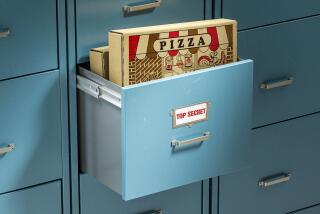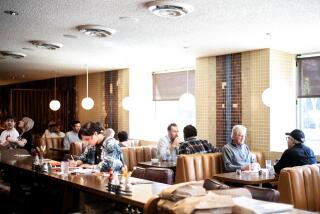Packed with memories
- Share via
Washington — The ruby red slippers that Dorothy wore in “The Wizard of Oz” are on display on the third floor, and the armchairs that Archie and Edith Bunker occupied in “All in the Family” are on the first floor.
This week, the Smithsonian’s National Museum of American History opened its latest celebrity-laden exhibit, on the history of the American lunchbox. Naturally, it’s in the cafeteria.
The metal lunchbox has a special place in the hearts of baby boomers. Described by Whole Pop Magazine Online as “the ultimate in personal expression,” the lunchbox was more than a vessel for tuna sandwiches and Oreo cookies -- it was a form of self expression and an early source of cachet. It said something about your character if you carried GI Joe or Wonder Woman, or lugged Superman or Barbie. And before the era of product placement, the lunchbox was a niche-market opportunity to promote the newest television stars.
On hand to open the exhibit were three celebrities -- Shirley Jones, Meadowlark Lemon and June Lockhart -- whose images graced many a lunchbox, particularly in the ‘60s and early ‘70s. Jones, the sweet-voiced matriarch of “The Partridge Family,” broke into song at the Tuesday opening, trilling out the show’s theme, “Come On, Get Happy.” “They have relics here,” she told the crowd. “I have finally become a relic in the Smithsonian.”
Lemon, who was the funniest player on the basketball-jiving Harlem Globetrotters and who was elected last year to the Basketball Hall of Fame, said he now considered himself part of the “Lunchbox Hall of Fame.” Lockhart, a twofer with her lunchbox roles in both “Lassie” and “Lost in Space,” may have spoken for all three when she said, “This is such a hoot.”
(David Hasselhoff of “Knight Rider” would have been there too, but he got food poisoning and had to skip lunch. And Henry Winkler appeared in a video about the exhibit, saying that the appearance of Fonzie on the “Happy Days” lunchbox -- coupled with an interview on National Public Radio -- convinced him he just might make it in Hollywood).
Many of the lunchboxes on display were donated by private collectors, including Thermos, the company that made many of them. Vintage lunchboxes have become collector’s items; a 1954 Superman lunchbox sold for $11,500 at Skinner’s Auction in Boston in March 2000.
David Shayt, the exhibit’s curator, said this was the Smithsonian’s “path-breaking attempt to enter the food area with a museum-quality exhibit. Lunchboxes and their bottles are fascinating storytellers, filled with the complexities of American childhood. The Smithsonian sees such food containers as memory boxes, where family and school merge with American popular culture.” The exhibit, which runs indefinitely, features 136 lunchboxes displayed along the corridor on the entry to the cafeteria.
Lunchboxes aren’t simply an artifact of the baby boomer era. A lunchbox accompanied Adm. Robert E. Peary in his expedition to the North Pole and others sat next to Charles Lindbergh and Amelia Earhart as they made their historic solo flights. For the first generations of Americans taking lunch to work -- a habit that began in the 1890s -- the box was an effort to bring the comforts of home to the harshness of the industrial workplace. Often a plain metal bucket or a sturdy dinner pail, the early lunch carrier allowed miners, factory workers and dockhands to carry vegetables, meat, coffee and pie to work. Lunch improved in 1904, when Thermos introduced its first “vacuum flask,” and workers could keep their drinks hot or cold “until the noon whistle blew.”
But it was really television -- and the explosion of market-savvy attention to style rather than utility -- that put the lunchbox in the Smithsonian and convinced consumers to buy new items even when the old ones were still working. From 1950 to 1970, according to Whole Pop Magazine, an estimated 120 million lunchboxes were sold, more than one and a half for every boy and girl born in the population explosion after World War II.
Roy Rogers was the first celebrity whose image graced the front of a Thermos lunchbox, in part because Hopalong Cassidy had signed an earlier deal with rival Aladdin and Thermos sought to compete with its own singing cowboy. Much of the marketing was directed at children. Suddenly it was important to have a cool lunchbox, whether it was the classic tartan plaid or “Star Trek.”
The metal lunchbox fell from favor in the 1970s, when manufacturers, reportedly to cut costs and assuage parental concerns, switched to plastic. (Curator Shayt notes, however, that the metal lunchbox was rugged enough to withstand the fumes and flavors of the school cafeteria.) And the generation that came of age eating lunch from metal boxes had by then moved on to other branding opportunities, such as T-shirts and Gucci bags.
Still, the lunchbox trend held the promise of memories, evocative and sometimes habit-forming. Rich Dias, vice president of marketing for Thermos, said he had a “Kung Fu” lunchbox, “and it inspired me to get involved in martial arts.”
Looking at the Globetrotters lunchbox in a glass case in the cafeteria, Meadowlark Lemon, who is now an ordained minister, said he did not think that the image on a 1971 lunchbox really looked like him, but he acknowledged that it “caught some of my gestures.”
Winkler, reached by phone in Pennsylvania, where he is on a speaking tour, said he was honored to be included in the lunchbox exhibit. “The fact that in my life I am represented in the Smithsonian twice is beyond language,” he said. “It defines a moment of pride.”
The other time? The jacket Winkler wore as the Fonz is already in the museum. It’s on the first floor.
More to Read
Sign up for The Wild
We’ll help you find the best places to hike, bike and run, as well as the perfect silent spots for meditation and yoga.
You may occasionally receive promotional content from the Los Angeles Times.






